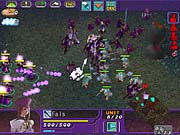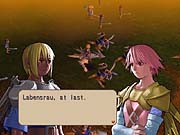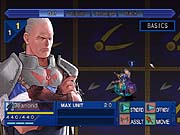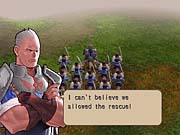Hundred Swords Preview
We take a look at this real-time strategy game from the creators of Jet Grind Radio.

Originally designed by Smilebit--the same development team responsible for Jet Grind Radio--for arcades and the Dreamcast, Hundred Swords was supposed to be one of Sega's earliest online games for the system. While the game made it out in Japan with full Internet multiplayer capabilities, Sega of America didn't see fit to bring Hundred Swords out here due to the untimely demise of the Dreamcast. Activision, which has ported several Dreamcast games to the PC within the past few months, has decided to bring Smilebit's real-time strategy game to the PC as a part of its value-priced line of games. We've had a chance to play through an early build of the game, and while it appears that some adjustments still need to be made, Hundred Swords has made the transition to the PC without any substantial problems. Of course, the notion that console strategy games lack the depth of most PC strategy games may apply in this case, but Activision hopes that Hundred Swords' combination of Myth-style gameplay (with limited resource management), as well as a deep and engrossing story, is enough for the PC audience to overlook the console strategy-game stereotype.

In the campaign mode of Hundred Swords, you assume the role of a young king named Larf Nalavale. During Larf's coronation in the Nalavale region of the continent, Mascar--one of the three other tribes on the continent--launches an attack on Larf's kingdom, seizing several key areas. The reason for the attack stems from the Mascar learning of secret negotiations between Larf and a young queen in another tribe and their desire to form an alliance. As you progress through the campaign mode, the story continues to unravel and eventually reveals that there's much more to these attacks than simple correspondence between two ruling monarchs.
If you want to avoid all of the game's story elements, Hundred Swords offers three other modes that essentially let you jump right into the action. In the practice mode, you'll be placed on a basic battlefield along with computer opponents. The only objective is to destroy all of the other enemy headquarters. This mode is perfect for becoming familiar with units and how they function, but it will also help you learn how to use resources. Since the enemy AI in this mode isn't exactly difficult to deal with, you'll also learn which strategies are most effective against certain types of units. For a little more variety, you can try out the mission mode, which basically functions as Hundred Swords' scenario option. The mission mode gives you five or so different scenarios to choose from in three difficulty settings--easy, medium, and hard. All of the easy missions have very basic objectives and straightforward maps with very few twists and turns. As you increase the difficulty, the objectives become much more difficult to complete, and the maps have been designed to make simple navigation an arduous task. If the computer isn't presenting enough of a challenge, Hundred Swords includes a multiplayer mode where up to four players can fight it out over dozens of maps featured in the game's other modes.
Unit Specifics

Though there are several types of units available, the gameplay in Hundred Swords revolves around a single unit known as the commander, which is always easy to spot on the battlefield because it doesn't have the same generic look as the other units and because it's usually the main character in the plot. The commander is the only unit that has the ability to construct buildings that process resources and the ability to build barracks that are capable of producing more units. In addition, the commander units are the only units capable of equipping new weapons, armor, or special items before the start of a battle. Basically, it all comes down to the basic idea that you must protect your commanding units at all costs; otherwise you have very little chance of achieving victory. This is especially important in the single-player campaign, where some mission objectives actually require that you keep a specific commander alive. Of course, it might seem like there's a simple solution to this problem that simply involves leaving your commanders behind at the base or in a safe area, but Hundred Swords counteracts this strategy by making the commander units so powerful that in most cases it would be unwise to leave them behind.

When you discover that certain strategies are more effective than others against a certain kind of enemy army, then you'll find that commanders can be expendable when the situation calls for it. For instance, the infantry units and their commander can serve as an excellent distraction for the archer and mage units, which can execute long-range attacks. While the enemy army is busy attacking your infantry, your archers, mages, and their respective commanders are at a safe distance, bombarding the enemy. If you time the attack well, then no more than three or four of your infantry will be killed, but improper timing or planning can result in some devastating losses. It really depends on the type of units the enemy is using. The aforementioned strategy works well against a relatively strong enemy force, but you should have no problem taking out a weaker group of enemies with a combination of cavalry and infantry units. Later in the game, when you and the enemy start to receive bigger and more powerful units, like airships, you'll have to rethink most of the strategies you've been using so that they take aerial bombardment into account.
There are a few scenarios in Hundred Swords that don't involve any kind of unit construction or resource management, so you have to rely on the units given to you and hope that there are reinforcements hidden somewhere on the map. But even in the missions that involve these two elements, you'll find that they're not as pronounced as in most other real-time strategy games. The resources in Hundred Swords correspond directly to specific types of units, so if you want to build more cavalry, you'll need more of that particular resource. It's a straightforward system, and since resources are almost always located within the immediate vicinity of your base, you should have no problem securing them.
The current build of Hundred Swords has a few shortcomings. The menu in which you select the commanders for the battle isn't incredibly intuitive and lacks any clear instructions. Graphically, there are some relatively bad aliasing problems and a very short draw distance, so there's plenty of fog when you're out on the battlefield. Otherwise, it looks like the translation is coming along well, and most of the features have been fully incorporated. Hundred Swords is scheduled for a release on February 5.
Got a news tip or want to contact us directly? Email news@gamespot.com
Join the conversation